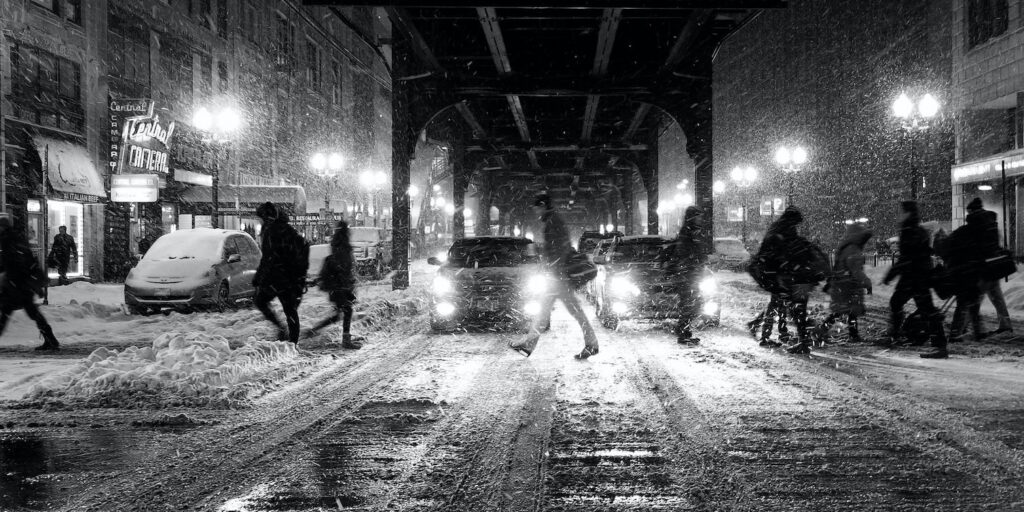- Optional coverage is the wrong way to cut insurance rates - April 22, 2024
- A primer on successfully claiming LTD benefits in Ontario - March 18, 2024
- Clear your sidewalks after a snowfall or you could face liability - February 7, 2024
By Paul Russell, LegalMatters Staff • Everyone knows that driving during the winter can be dangerous due to snow and ice.
But this time of year can also be hazardous for pedestrians, says Ontario personal injury lawyer Joshua Goldberg.
“Media reports often focus on auto accidents on our freeways caused by winter storms, while neglecting to mention that pedestrians are suffering injury, or even death, on small roadways,” says Goldberg, principal of Joshua Goldberg Law.
“Winter poses special risks to those walking or crossing the street,” he tells LegalMattersCanada.ca. “Sometimes the pedestrian’s action causes the accident but drivers also share some responsibility.”
More than 300 pedestrians are killed in Canada annually
On average, more than 300 pedestrians are killed in Canada annually, according to Statistics Canada. Drawing from data gathered from 2018 to 2020, it says intersections are the most common location for pedestrian deaths, with roughly 21 per cent of fatalities taking place while people are crossing an intersection or in a roundabout.
“While pedestrians did not always follow proper traffic signals, coroners and medical examiners indicated that some fatalities occurred even when the signals were followed,” StatsCan states. “Other commonly reported locations where pedestrian fatalities occurred include roadways at a non-intersection road (14 per cent), highways (13 per cent), parking lots or private property (10 per cent) and near railways (eight per cent).”
In Peel Region, 376 pedestrians were hit by automobiles in Mississauga and Brampton in 2022, and 14 were killed, according to a news report.
“It’s not just numbers, these are real people,” said Michael Stewart, Community Relations consultant with CAA. “That’s 14 folks who left their homes and didn’t make it back.”
Caledon has seen a steady rise in pedestrian collisions in the past three years, the article adds, noting that 14 pedestrians were struck by vehicles in the town in 2022.
Various causes for pedestrian injuries
Icy sidewalks are always dangerous for pedestrians, Goldberg says, adding most Ontario municipalities demand that property owners or occupiers clear and salt adjacent sidewalks within 12 to 24 hours after a storm.
“If someone fails to salt the sidewalk within a reasonable time and you slip and fall on a patch of ice, you could have grounds for compensation,” he says.
Goldberg says that pedestrians also have to exercise caution when walking and should not be impaired by alcohol or drugs.
- Your auto insurance policy is not as simple as it seems
- Pedestrian/auto accidents spike after a return to Standard Time
- Studies show that ‘Halloween is the deadliest night for pedestrians’
He points to the StatsCan report, which notes that the rate of male pedestrian fatalities involving alcohol, cannabis or other drug consumption was 2.0 times higher among pedestrians aged 20 to 59 years than among those over 60.
The report adds that 38 per cent of male pedestrians involved in nighttime accidents said they had previously consumed alcohol, cannabis or another drug before the accident.
How to stay safe
“Dusk comes early on a typical winter day, which results in decreased visibility for drivers,” says Goldberg. “That is why it is imperative that pedestrians do all they can to ensure they are visible to passing motorists.”
He says that can be achieved by wearing light-coloured clothing or by having reflective material on your boots or jacket.
“If you are dressed in all black and the street lights are not good, drivers will have trouble seeing you after dark,” he says.
The Ontario government says it is important that pedestrians cross the street at marked interchanges and keep an eye out for oncoming traffic.
“Cross only when the driver has fully stopped and hold your hand out in front of you indicating you are waiting to cross the road,” the province advises. “Make sure drivers see you before you cross, make eye contact before stepping onto the road.”
Distracted pedestrians are common on our sidewalks, as people text, talk on cellphones and or use earphones to block out road noise. According to the American Academy of Orthopaedic Surgeons, distraction may have been a contributing factor in the 4,200 U.S. pedestrian deaths and 70,000 injuries in traffic crashes in 2010.
The Academy states that a study looked at headphones and pedestrian distraction. Of 116 reported deaths involving pedestrians wearing headphones, 68 per cent were male and 67 per cent were under the age of 30.
“Seventy-four percent of case reports stated that the victim was wearing headphones at the time of the crash,” it states.
In 2017 a private member’s bill sought to curb distracted walking in the province. According to a media report it called for a $50 fine on the first offence, $75 on a second offence and $125 for third and subsequent violations under the Highway Traffic Act. The bill effectively died when its author failed to win re-election.
What to do after an injury
“Your health is your primary concern after an injury as a pedestrian,” says Goldberg. “Call 911 if you need immediate health care.”
He advises people who are able to take photos of the scene and what conditions may have contributed to the accident, such as snow-covered roadways.
“If an auto was involved, be sure to get the licence plate number and the driver’s name and contact information,” Goldberg says. “If anyone else witnessed what happened, record their names and contact information also, plus an account of what they saw.”
Getting in touch with a personal injury lawyer is also recommended, he says.
“If you suffered a pedestrian injury due to someone’s negligence, you may be entitled to compensation,” Goldberg says. “Don’t suffer in silence but reach out to a lawyer and see what your options are.”

